Biermann Ch. Handbook of Pulping and Papermaking
Подождите немного. Документ загружается.

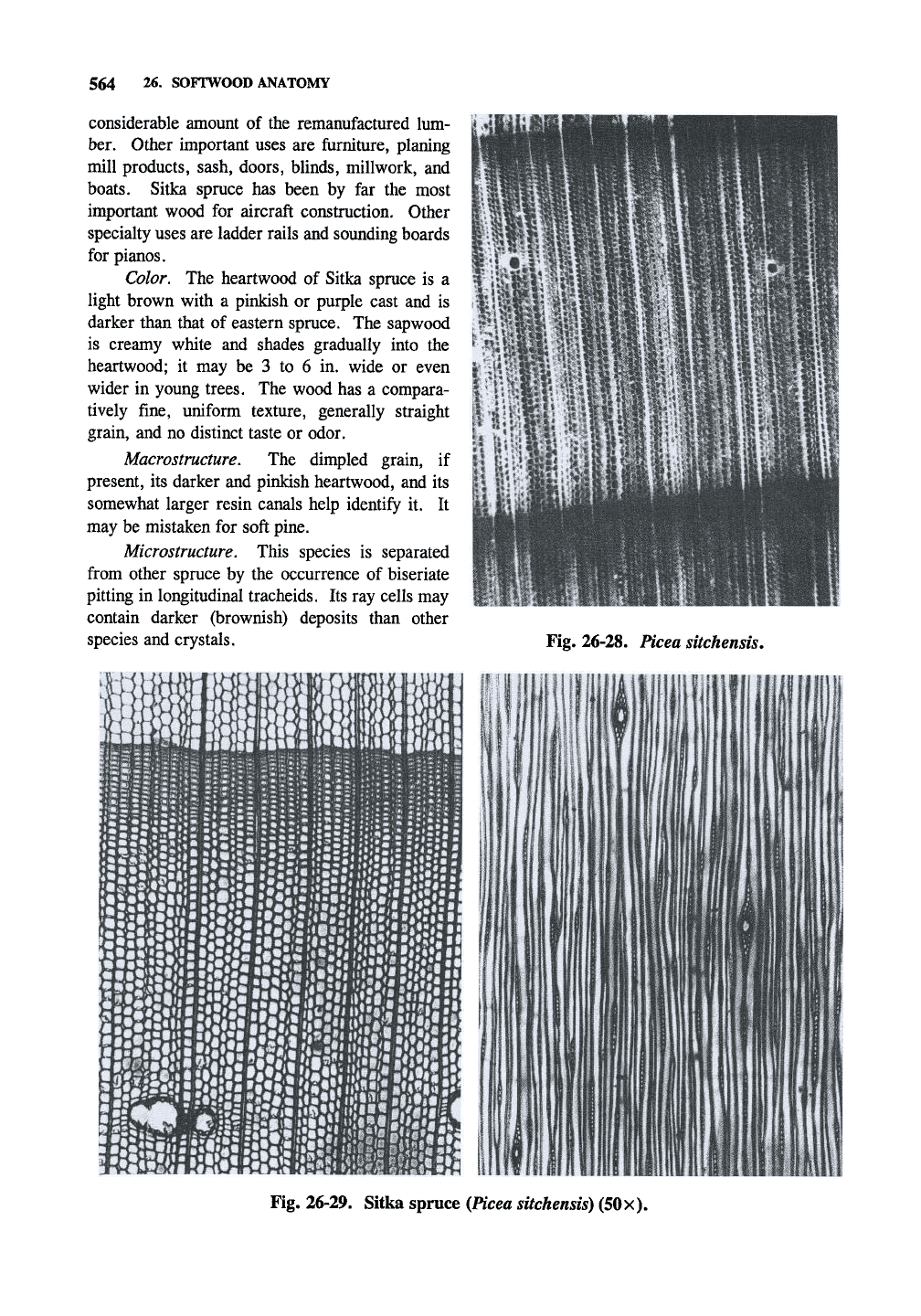
564 26. SOFTWOOD ANATOMY
considerable amount of the remanufactured lum-
ber. Other important uses are furniture, planing
mill products, sash, doors, blinds, mill work, and
boats.
Sitka spruce has been by far the most
important wood for aircraft construction. Other
specialty uses are ladder rails and sounding boards
for pianos.
Color. The heartwood of Sitka spruce is a
light brown with a pinkish or purple cast and is
darker than that of eastern spruce. The sapwood
is creamy white and shades gradually into the
heartwood; it may be 3 to 6 in. wide or even
wider in young trees. The wood has a compara-
tively fine, uniform texture, generally straight
grain, and no distinct taste or odor.
Macrostructure. The dimpled grain, if
present, its darker and pinkish heartwood, and its
somewhat larger resin canals help identify it. It
may be mistaken for soft pine.
Microstructure. This species is separated
from other spruce by the occurrence of biseriate
pitting in longitudinal tracheids. Its ray cells may
contain darker (brownish) deposits than other
species and crystals.
Fig. 26-28. Picea sitchensis.
Fig. 26-29. Sitka spruce (Picea sitchensis) (50x).

ANATOMY OF SOFTWOOD SPECIES 565
Engelmann spruce (Fig. 26-30)
Engelmann spruce
{Picea engelmannii)
grows
at high elevations in the Rocky Mountain region of
the United States. It is known by other names,
such as white spruce, mountain spruce, Arizona
spruce, silver spruce, and balsam. About 60% of
the lumber comes from the southern Rocky Moun-
tain States, with most of the remainder from the
northern Rocky Mountain States and Oregon.
Uses. The wood has medium to fine texture.
It is generally straight grained. Engehnann spruce
is rated as light in weight. It is low in strength as
a beam or post. It is limber, soft, low in shock
resistance, and has moderately small shrinkage.
The lumber typically contains numerous small
knots.
Engelmann spruce is used for lumber,
mine timbers, railroad ties, and poles. It is used
also in building construction in the form of dimen-
sion stock, flooring, sheathing, and studding. It
has excellent properties for pulp and papermaking.
Color. The heartwood of Engelmann spruce
is nearly white with a slight tinge of red. The
sapwood is 3/4 to 2 in. wide and is often difficult
to distinguish from heartwood, except for its high
moisture content in green timbers.
Macroscopic features. The transition from
earlywood to latewood is somewhat more abrupt
than in other spruces. Resin canals are present,
comparatively few, and are often difficult to find.
They often appear as white dots in the latewood.
The rays are very fine; the ftisiform rays occur
sporadically and are widely spaced.
Similar woods. Engelmann spruce is easily
confused with the white (true) firs and lodgepole
pine,
which have almost white heartwoods. The
true firs lack resin canals. Engelmann spruce
lacks the dimpled surface of lodgepole pine.
Norway spruce
Norway spruce {P. abies) is native to Eu-
rope.
It has been planted in the northeast U.S.
ABIES
Uses. The white firs are very useful in pulp
products and produces strong, high-quality paper.
Color. The wood of the true firs {Abies) is
creamy white to pale brown. The heartwood and
sapwood are usually indistinguishable. The simi-
larity of wood structure in the true firs makes it
Fig. 26-30.
Picea engelmannii
(Koehler, 1917)
15
x.
impossible to distinguish the species by an exami-
nation of the wood alone. Firs tend to be intoler-
ant (of shade, when growing) and are, therefore,
often fast growing with wide growth rings having
especially gradual transition to latewood.
Fig,
26-31.
Abies spp.
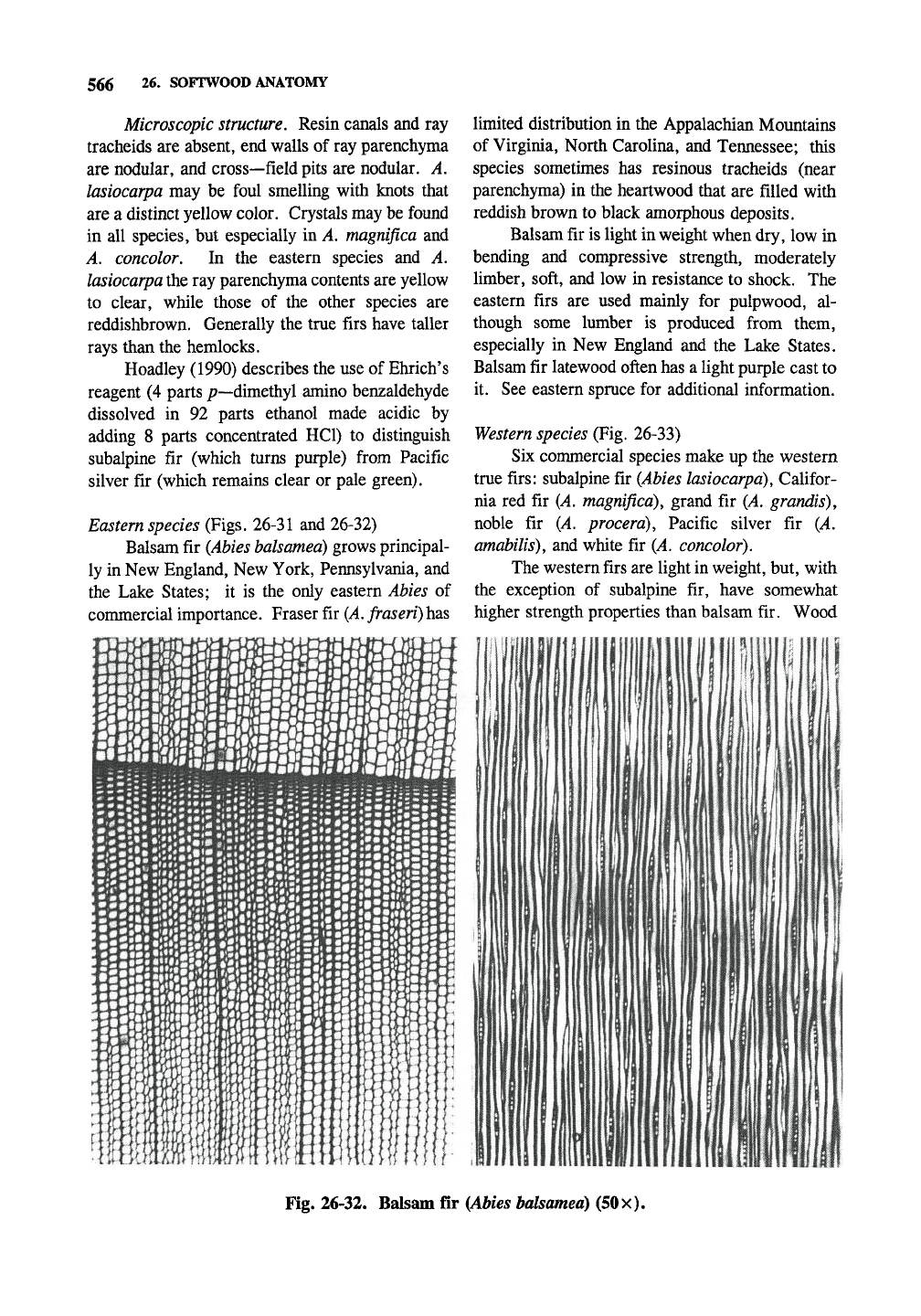
566 26. SOFTWOOD ANATOMY
Microscopic structure. Resin canals and ray
tracheids are absent, end walls of ray parenchyma
are nodular, and cross—field pits are nodular. A.
lasiocarpa may be foul smelling with knots that
are a distinct yellow color. Crystals may be found
in all species, but especially in A. magnifica and
A.
concolor. In the eastern species and A,
lasiocarpa
the ray parenchyma contents are yellow
to clear, while those of the other species are
reddishbrown. Generally the true firs have taller
rays than the hemlocks.
Hoadley (1990) describes the use of Ehrich's
reagent (4 parts /^—dimethyl amino benzaldehyde
dissolved in 92 parts ethanol made acidic by
adding 8 parts concentrated HCl) to distinguish
subalpine fir (which turns purple) from Pacific
silver fir (which remains clear or pale green).
Eastern species (Figs. 26-31 and 26-32)
Balsam fir
{Abies balsamea)
grows principal-
ly in New England, New York, Pennsylvania, and
the Lake States; it is the only eastern Abies of
commercial importance. Eraser fir (.4. fraseri) has
limited distribution in the Appalachian Mountains
of Virginia, North Carolina, and Tennessee; this
species sometimes has resinous tracheids (near
parenchyma) in the heartwood that are filled with
reddish brown to black amorphous deposits.
Balsam fir is light in weight when dry, low in
bending and compressive strength, moderately
limber, soft, and low in resistance to shock. The
eastern firs are used mainly for pulpwood, al-
though some lumber is produced from them,
especially in New England and the Lake States.
Balsam fir latewood often has a light purple cast to
it. See eastern spruce for additional information.
Western
species (Fig. 26-33)
Six commercial species make up the western
true firs: subalpine fir
{Abies
lasiocarpa), Califor-
nia red fir (.4. magnifica), grand fir {A. grandis),
noble fir {A. procera). Pacific silver fir {A.
amabilis),
and white fir {A. concolor).
The western firs are light in weight, but, with
the exception of subalpine fir, have somewhat
higher strength properties than balsam fir. Wood
Fig. 26-32. Balsam fir (Abies
balsamea)
(50x).
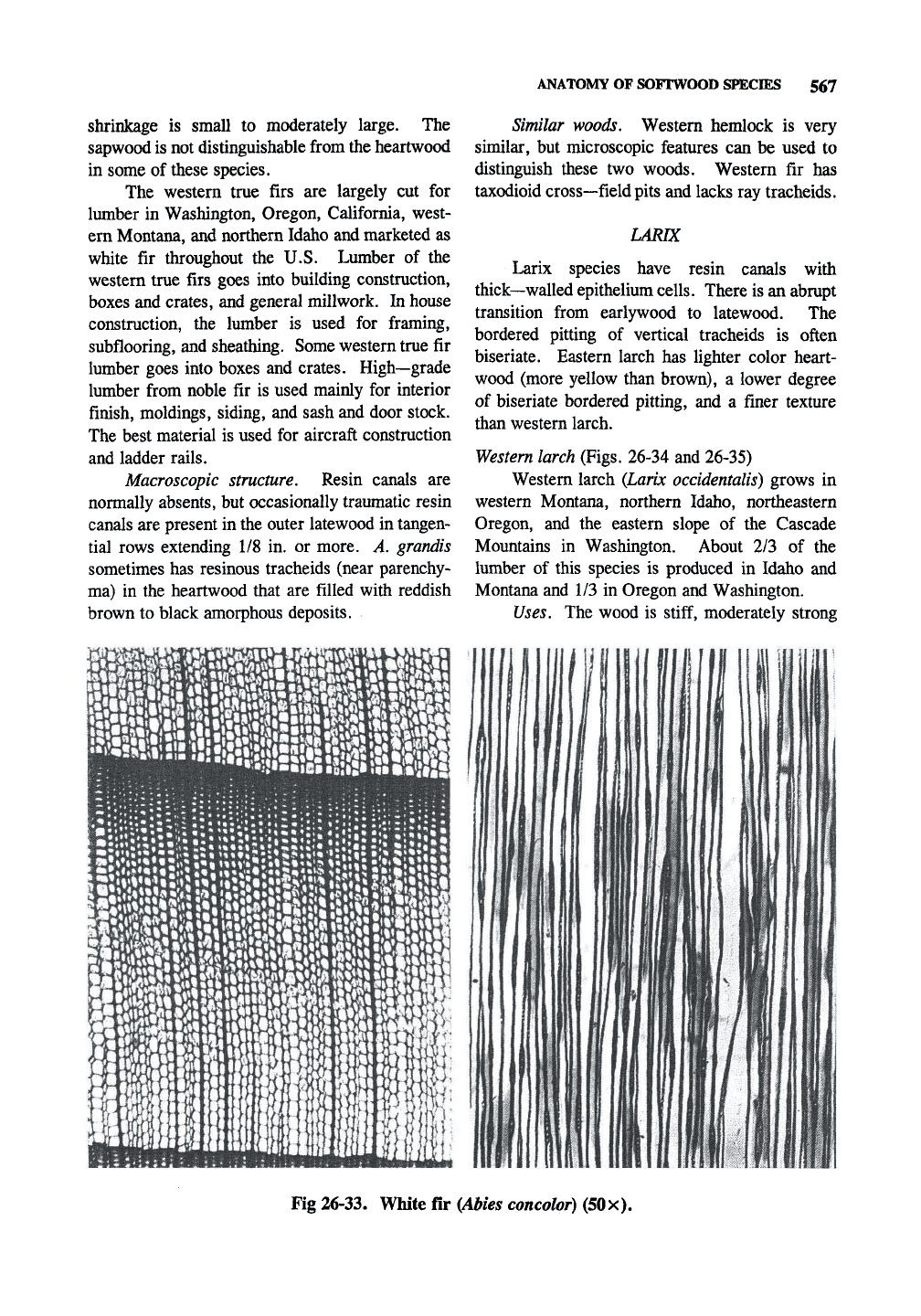
ANATOMY OF SOFTWOOD SPECIES 567
shrinkage is small to moderately large. The
sapwood is not distinguishable from the heartwood
in some of these species.
The western true firs are largely cut for
lumber in Washington, Oregon, California, west-
em Montana, and northern Idaho and marketed as
white fir throughout the U.S. Lumber of the
western true firs goes into building construction,
boxes and crates, and general millwork. In house
construction, the lumber is used for framing,
subflooring, and sheathing. Some western true fir
lumber goes into boxes and crates. High—grade
lumber from noble fir is used mainly for interior
finish, moldings, siding, and sash and door stock.
The best material is used for aircraft construction
and ladder rails.
Macroscopic structure. Resin canals are
normally absents, but occasionally traumatic resin
canals are present in the outer latewood in tangen-
tial rows extending 1/8 in. or more. A. grandis
sometimes has resinous tracheids (near parenchy-
ma) in the heartwood that are filled with reddish
brown to black amorphous deposits.
Similar woods. Western hemlock is very
similar, but microscopic features can be used to
distinguish these two woods. Western fir has
taxodioid cross—field pits and lacks ray tracheids.
LARIX
Larix species have resin canals with
thick—walled epithelium cells. There is an abrupt
transition from earlywood to latewood. The
bordered pitting of vertical tracheids is often
biseriate. Eastern larch has lighter color heart-
wood (more yellow than brown), a lower degree
of biseriate bordered pitting, and a finer texture
than western larch.
Western
larch (Figs. 26-34 and 26-35)
Western larch {Larix occidentalis) grows in
western Montana, northern Idaho, northeastern
Oregon, and the eastern slope of the Cascade
Mountains in Washington. About 2/3 of the
lumber of this species is produced in Idaho and
Montana and 1/3 in Oregon and Washington.
Uses. The wood is
stiff,
moderately strong
Fig 26-33. White fir (A6fe5co/ico/(ir)(50x).
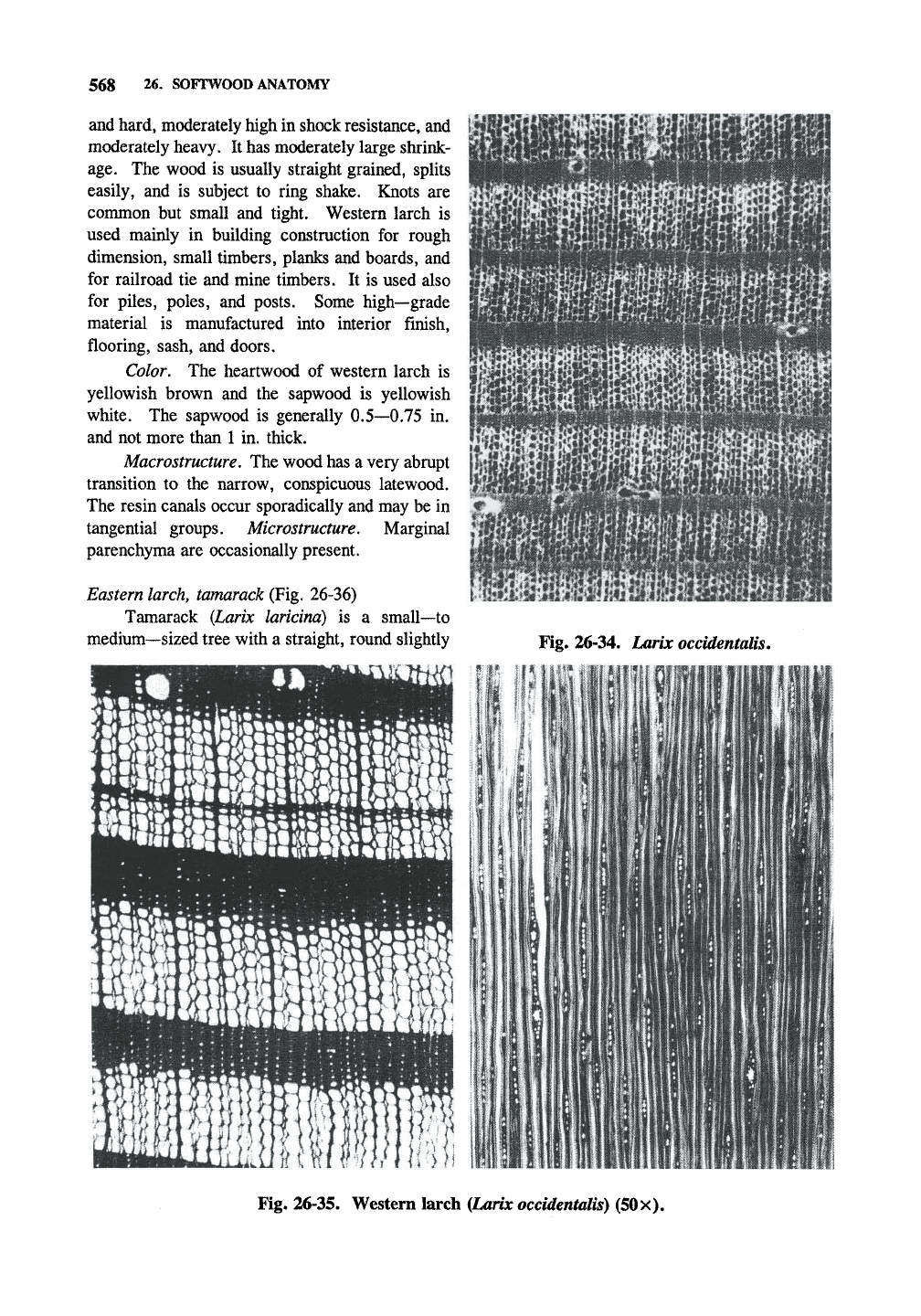
568 26. SOFTWOOD ANATOMY
and hard, moderately high in shock resistance, and
moderately heavy. It has moderately large shrink-
age.
The wood is usually straight grained, splits
easily, and is subject to ring shake. Kiiots are
common but small and tight. Western larch is
used mainly in building construction for rough
dimension, small timbers, planks and boards, and
for railroad tie and mine timbers. It is used also
for piles, poles, and posts. Some high—grade
material is manufactured into interior finish,
flooring, sash, and doors.
Color. The heartwood of western larch is
yellowish brown and the sapwood is yellowish
white. The sapwood is generally 0.5—0.75 in.
and not more than 1 in. thick.
Macrostructure. The wood has a very abrupt
transition to the narrow, conspicuous latewood.
The resin canals occur sporadically and may be in
tangential groups. Microstructure. Marginal
parenchyma are occasionally present.
Eastern
larch,
tamarack (Fig. 26-36)
Tamarack {Larix laricina) is a small—to
medium—sized tree with a straight, round slightly
Fig. 26-34. Larix occidentalis.
Fig. 26-35. Western larch {Larix
occidentalis)
(50x).
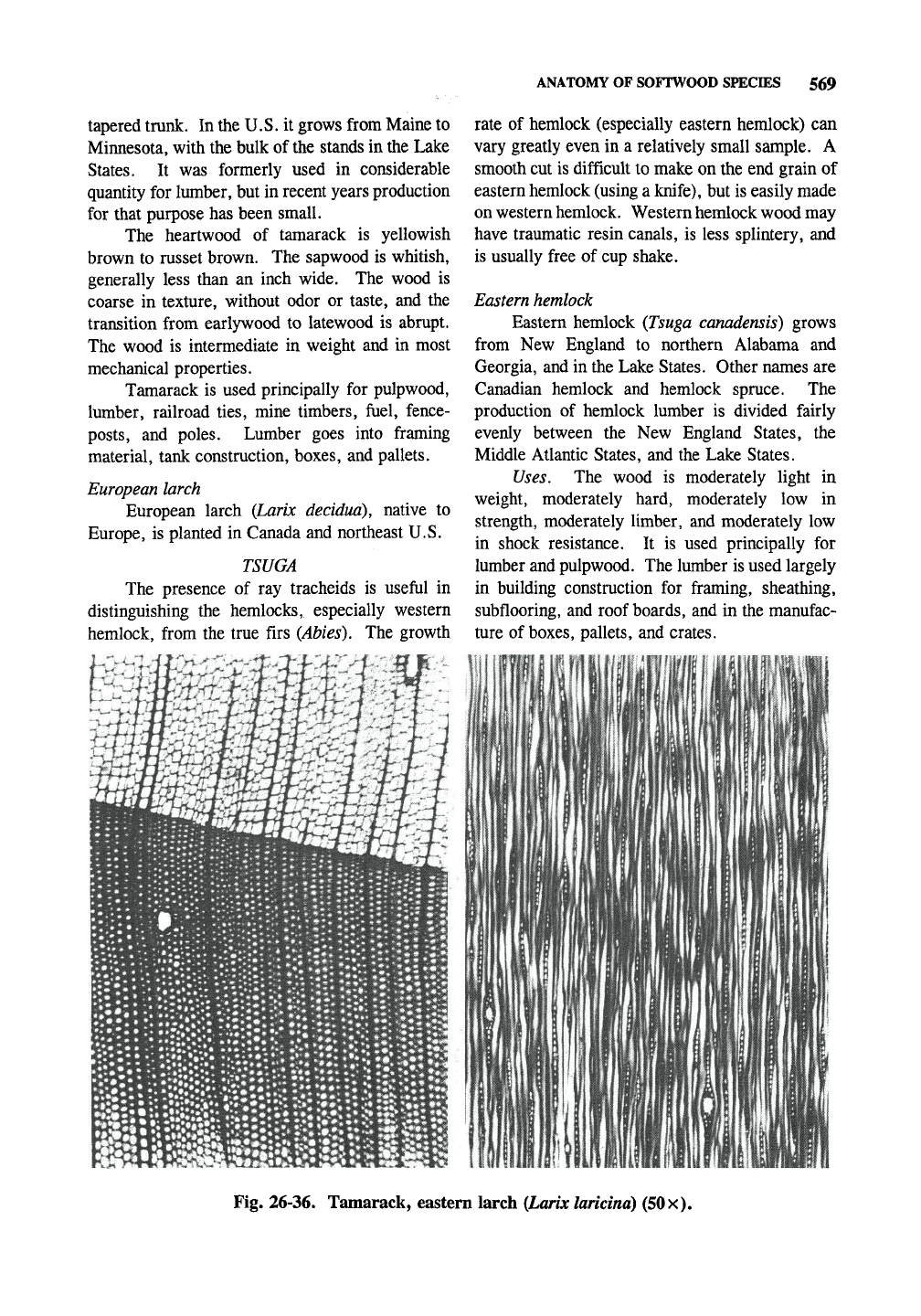
tapered trunk. In the U.S. it grows from Maine to
Minnesota, with the bulk of the stands in the Lake
States. It was formerly used in considerable
quantity for lumber, but in recent years production
for that purpose has been small.
The heartwood of tamarack is yellowish
brown to russet brown. The sapwood is whitish,
generally less than an inch wide. The wood is
coarse in texture, without odor or taste, and the
transition from earlywood to latewood is abrupt.
The wood is intermediate in weight and in most
mechanical properties.
Tamarack is used principally for pulpwood,
lumber, railroad ties, mine timbers, fuel, fence-
posts,
and poles. Lumber goes into framing
material, tank construction, boxes, and pallets.
European larch
European larch {Larix decidua), native to
Europe, is planted in Canada and northeast U.S.
TSUGA
The presence of ray tracheids is useful in
distinguishing the hemlocks, especially western
hemlock, from the true firs {Abies). The growth
ANATOMY OF SOFTWOOD SPECffiS 569
rate of hemlock (especially eastern hemlock) can
vary greatly even in a relatively small sample. A
smooth cut is difficult to make on the end grain of
eastern hemlock (using a knife), but is easily made
on western hemlock. Western hemlock wood may
have traumatic resin canals, is less splintery, and
is usually free of cup shake.
Eastern
hemlock
Eastern hemlock (Tsuga canadensis) grows
from New England to northern Alabama and
Georgia, and in the Lake States. Other names are
Canadian hemlock and hemlock spruce. The
production of hemlock lumber is divided fairly
evenly between the New England States, the
Middle Atlantic States, and the Lake States.
Uses. The wood is moderately light in
weight, moderately hard, moderately low in
strength, moderately limber, and moderately low
in shock resistance. It is used principally for
lumber and pulpwood. The lumber is used largely
in building construction for framing, sheathing,
subflooring, and roof
boards,
and in the manufac-
ture of boxes, pallets, and crates.
Fig. 26-36. Tamarack, eastern larch
{Larix laricina) (50
x).

570 26. SOFTWOOD ANATOMY
Color. The heartwood of eastern hemlock is
pale brown with a reddish hue. The sapwood is
not distinctly separated from the heartwood but
may be lighter in color. The wood is coarse and
uneven in texture (old trees tend to have consider-
able shake).
Similar woods. Spruce is lighter in color,
weighs less, does not tend to splinter, and has
resin canals. Most of the firs are of light color,
especially in the earlywood, and do not tend to
splinter. Noble fir should be distinguished with a
microscope.
Western hemlock (Figs. 26-37 and 26-38)
Western hemlock (Tsuga
heterophylla)
(alias
west coast hemlock, hemlock spruce, western
hemlock spruce, western hemlock fir. Prince
Albert fir, gray fir, silver fir, and Alaska pine)
grows along the Pacific coast of Oregon and
Washington and in the northern Rocky Mountains,
north to Canada and Alaska. Mountain hemlock,
T. mertensiana, inhabits mountainous country from
central California to Alaska; it is treated as a
separate species in assigning lumber properties.
Fig. 26-37.
Tsuga
heterophylla.
Fig. 26-38. Western hemlocl^
{Tsuga heterophylla)
(50x).
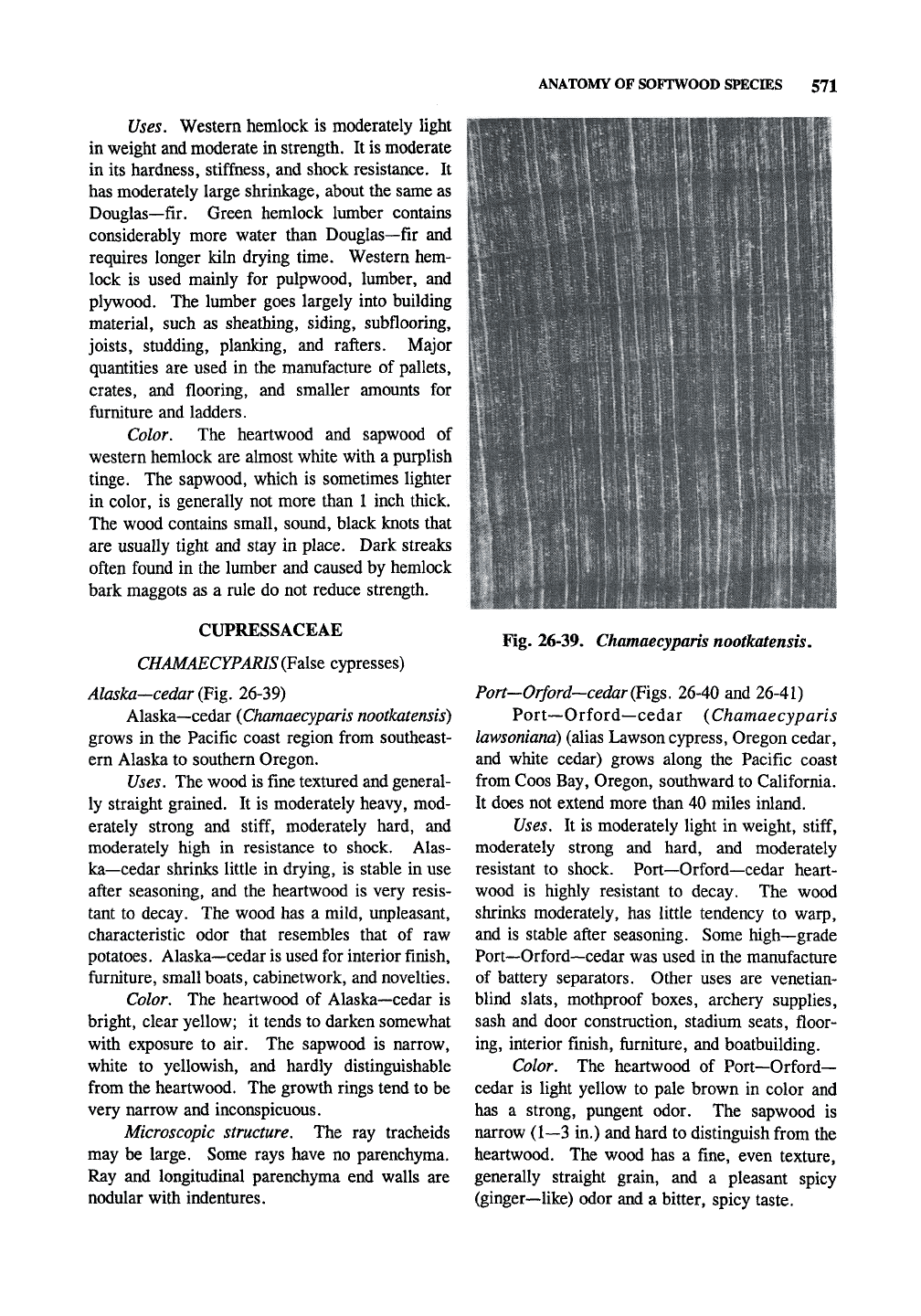
ANATOMY
OF
SOFTWOOD SPECIES
571
Uses. Western hemlock
is
moderately light
in weight and moderate
in
strength.
It is
moderate
in
its
hardness, stiffness,
and
shock resistance.
It
has moderately large shrinkage, about
the
same
as
Douglas—fir. Green hemlock lumber contains
considerably more water than Douglas—fir
and
requires longer kiln drying time. Western hem-
lock
is
used mainly
for
pulpwood, lumber,
and
plywood.
The
lumber goes largely into building
material, such
as
sheathing, siding, subflooring,
joists,
studding, planking,
and
rafters. Major
quantities
are
used
in the
manufacture
of
pallets,
crates,
and
flooring,
and
smaller amounts
for
ftirniture and ladders.
Color.
The
heartwood
and
sapwood
of
western hemlock
are
almost white with
a
purplish
tinge.
The
sapwood, which
is
sometimes lighter
in color,
is
generally
not
more than
1
inch thick.
The wood contains small, sound, black knots that
are usually tight
and
stay
in
place. Dark streaks
often found
in the
lumber
and
caused
by
hemlock
bark maggots
as a
rule
do not
reduce strength.
CUPRESSACEAE
CHAMAECYPARISiVdXst
cypresses)
Alaska—cedar (¥\g. 26-39)
Alaska—cedar
(Chamaecyparis
nootkatensis)
grows
in the
Pacific coast region from southeast-
ern Alaska
to
southern Oregon.
Uses. The wood
is
fine textured and general-
ly straight grained.
It is
moderately heavy, mod-
erately strong
and stiff,
moderately hard,
and
moderately high
in
resistance
to
shock. Alas-
ka—cedar shrinks little
in
drying,
is
stable
in use
after seasoning,
and the
heartwood
is
very resis-
tant
to
decay.
The
wood
has a
mild, unpleasant,
characteristic odor that resembles that
of raw
potatoes. Alaska—cedar is used
for
interior finish,
furniture, small boats, cabinetwork,
and
novelties.
Color.
The
heartwood
of
Alaska—cedar
is
bright, clear yellow;
it
tends
to
darken somewhat
with exposure
to air. The
sapwood
is
narrow,
white
to
yellowish,
and
hardly distinguishable
from
the
heartwood.
The
growth rings tend
to be
very narrow
and
inconspicuous.
Microscopic structure.
The ray
tracheids
may
be
large. Some rays have
no
parenchyma.
Ray
and
longitudinal parenchyma
end
walls
are
nodular with indentures.
Fig. 26-39. Chamaecyparis nootkatensis.
Port—Orford—cedar (Figs. 26-40
and
26-41)
Port—Orford—cedar (Chamaecyparis
lawsoniana)
(alias Lawson cypress, Oregon cedar,
and white cedar) grows along
the
Pacific coast
from Coos
Bay,
Oregon, southward
to
California.
It does
not
extend more than
40
miles inland.
Uses.
It is
moderately light
in
weight,
stiff,
moderately strong
and
hard,
and
moderately
resistant
to
shock. Port—Orford—cedar heart-
wood
is
highly resistant
to
decay.
The
wood
shrinks moderately,
has
little tendency
to
warp,
and
is
stable after seasoning. Some high—grade
Port—Orford—cedar
was
used
in the
manufacture
of battery separators. Other uses
are
venetian-
blind slats, mothproof boxes, archery supplies,
sash
and
door construction, stadium seats, floor-
ing, interior finish, furniture,
and
boatbuilding.
Color.
The
heartwood
of
Port—Orford—
cedar
is
light yellow
to
pale brown
in
color
and
has
a
strong, pungent odor.
The
sapwood
is
narrow (1—3
in.)
and hard
to
distinguish from
the
heartwood.
The
wood
has a
fine, even texture,
generally straight grain,
and a
pleasant spicy
(ginger—like) odor
and a
bitter, spicy taste.

572 26. SOFTWOOD ANATOMY
Macroscopic structure. Longitudinal paren-
chyma are usually visible (wetting helps) with a
lens as reddish lines or zones.
Microscopic structure. Ray tracheids are
lacking, ray parenchyma have smooth end walls,
and the transverse walls of the vertical parenchy-
ma are nodular.
Atlantic white—cedar
This species is strictly a swamp tree and is
very similar in properties and uses to northern red
cedar; both grow in the eastern U.S.
Chamaecyparis thyoids is also known as juniper,
southern white—cedar, swamp cedar, and boat
cedar; it grows near the Atlantic coast from
Maine to northern Florida and westward along the
gulf coast to Louisiana. Commercial production
centers in North Carolina and along the gulf coast.
White—cedar lumber is used principally where a
high degree of durability is needed, as in tanks
and boats, and for woodenware.
Color. The heartwood is light brown with a
reddish cast that is sharply demarcated from the
sapwood. It is aromatic and has a similar odor to
that of northern white—cedar.
Fig. 26-40. Chamaecyparis lawsoniana.
Fig.
26-41.
Port-Orford cedar
{Chamaecyparis lawsoniana)
(50x).
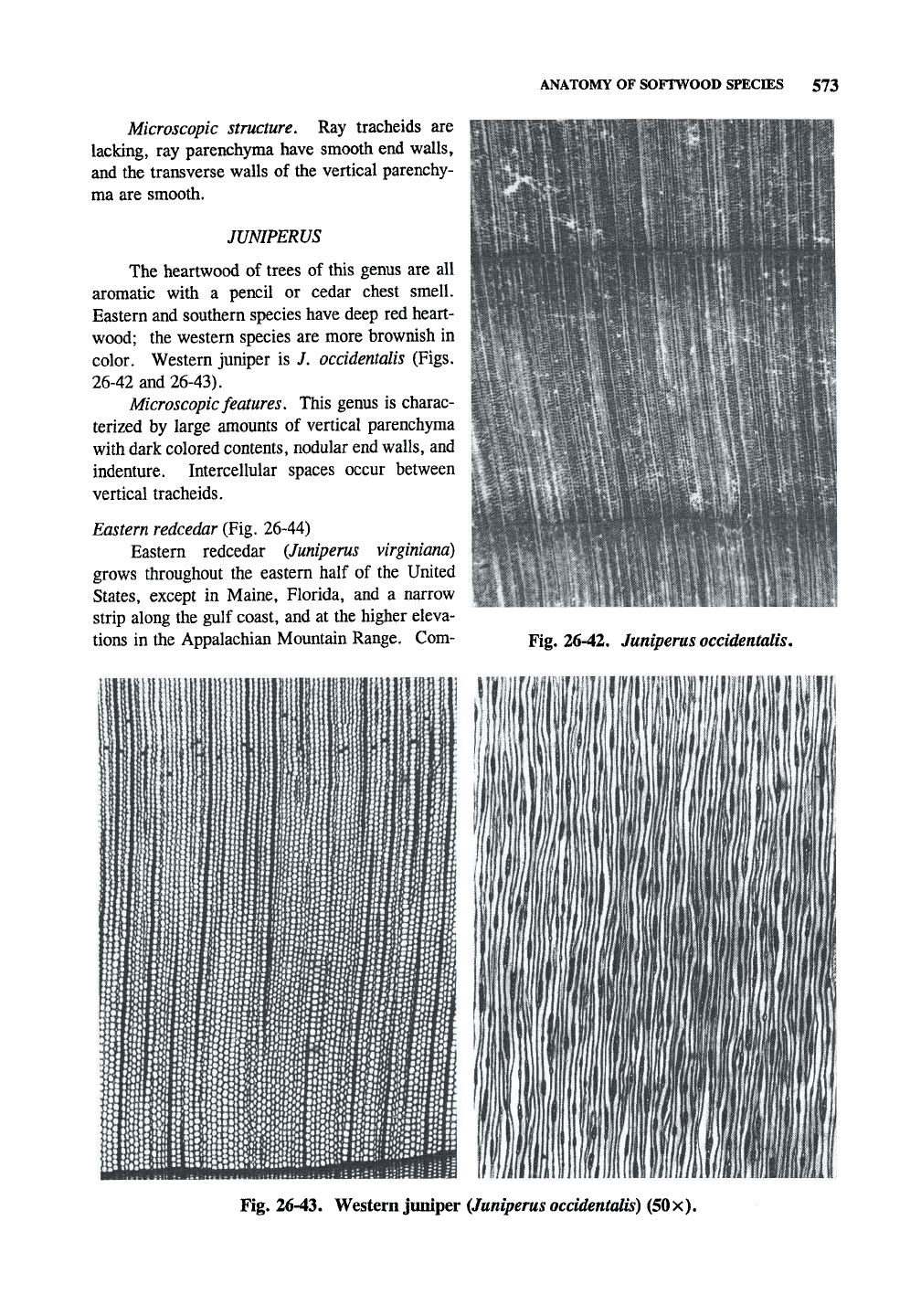
ANATOMY OF SOFTWOOD SPECIES 573
Microscopic structure. Ray tracheids are
lacking, ray parenchyma have smooth end walls,
and the transverse walls of the vertical parenchy-
ma are smooth.
JUNIPERUS
The heartwood of trees of this genus are all
aromatic with a pencil or cedar chest smell.
Eastern and southern species have deep red heart-
wood; the western species are more brownish in
color. Western juniper is J. occidentalis (Figs.
26-42 and 26-43).
Microscopic features. This genus is charac-
terized by large amounts of vertical parenchyma
with dark colored contents, nodular end
walls,
and
indenture. Intercellular spaces occur between
vertical tracheids.
Eastern redcedar (Fig. 26-44)
Eastern redcedar (Juniperus virginiana)
grows throughout the eastern half of the United
States, except in Maine, Florida, and a narrow
strip along the gulf coast, and at the higher eleva-
tions in the Appalachian Mountain Range. Com-
Fig. 26-42. Juniperus occidentalis.
Fig. 26-43. Western juniper
{Juniperus occidentalis)
(50
X).
